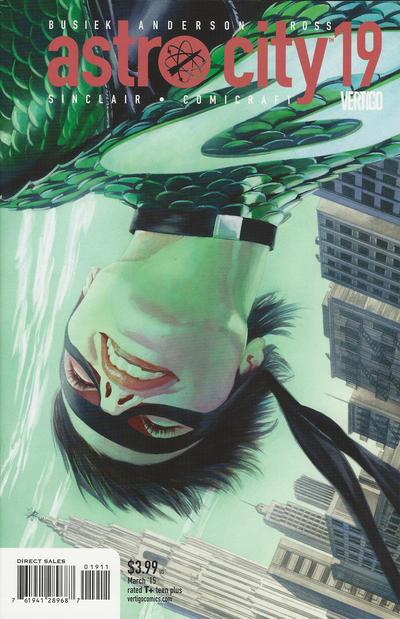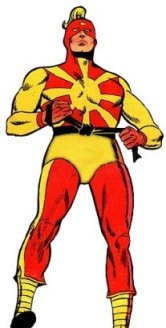Astro City MetroBook 5 continues to collect the outstanding series from Kurt Busiek, Brent Anderson and Alex Ross. The saga of this bizarre town which has enticing echoes of other comic book universes, unfolds with the same naturalism which informed its earliest installments. I am sometimes amazed at how complete a vision Astro City has always been and continues to be. As we learn about new denizens in and around Astro City through many decades, it's as if they have always been part of the fabric.

Astro City 11 introduces us to The Silver Adept who is something of a "sorceress supreme" for the Astro City universe. But we learn that it takes nigh a village to make the Adept's work effective as we are told the story through the eyes of her personal assistant Raitha, and we meet among others the horned domestic Orn. While the Adept deals with all manner of bizarre problems across multiple dimensions, it's up to Raitha and Orn to hold down the fort and deal with problems which inevitably rear up.

Graham Nolan slips in to illustrate the story of Ned Carroway in Astro City 12. Ned is a small-time hood who is part of a sub-category of villains who fancy themselves rogues who engage in sartorial splendor. It's less the loot than the look that drives these obsessive types to grab some distinctive outfits and rob a bank or three. Ned is a bit of a loser though, captured time and again and a man who throws away romance and a family to feed his need to rob and look awesome doing it. He fancies himself a wolf in a world where wolves are hardly ignored.

Astro City 13 introduces the reader to the Dancing Master, a mystical entity who comes to the city and brings with him romance. People set aside their responsibilities and find someone to love. One couple realizes they have to make time for each other. At the same time a hood named Gundog is robbing banks in sequence just to see if he can. His bravado and charisma attract at least one young woman who absconds with him after they dump the loot. They've found something more important than thrills and wealth.
It takes two issues of Astro City to tell the story of a reclusive woman named Ellie who takes care of abandoned robots. She seems to have an uncanny knack for repairing robots which have been used by villains. Her little operation is isolated, and she is happy to scrape by on donations. When her nephew Fred shows up, his ambitions change the game and we learn that there's much, much more to Aunt Ellie than we'd imagined.
Identity is the core aspect of the story in Astro City sixteen where we meet Starbright, a hero of a small town outside of Astro City. He's a hero who is more interested in reforming his arch villain Simon Sez than capturing him. When the very youthful Simon makes a request in exchange for help with crime busting, Starbright takes him up on it. But this story is about secrets and about finding out who you are, and it's hardly obvious to everyone. The secret we learn is one that challenges our society a great deal in our modern day.




Then we are treated to one of Astro City's best stories in a four-part sequence which gives us a close look at Quarrel and Crackerjack. The former is a woman from my part of the country, the hills of Eastern Kentucky who grew up with an alcoholic mom and a distant dad, who turned out to the villainous Quarrel. She takes on the responsibility to raise her brothers, but when she finds her dad's old gear becomes a heroic Quarrel, one driven to prove something to everyone, herself included. She finds a soulmate of sorts in Crackerjack, a brash hero who like Quarrel only has his own skills developed and honed to their peek to battle crime. They are a pair, lusty lovers and rowdy partners in a tempestuous relationship that lasts years. When we meet them at the beginning of this story, they are feeling the pangs of age and doubting the road forward. There are some poor choices made. And some good ones as well. This one literally brought tears to my eyes.

It's more growing up tales as we meet the mother and daughter team who become Hummingbird. The former was a crimefighter who used artificial tools to be effective while the latter is gifted with magical powers which seem to be taking her over. Her powers come from the land of her father, and she sadly discover there's a curse embedded inside the gifts. Jesus Merino steps in to draw this installment for Astro City 25.

In Astro City 26, an issue which celebrates two decades of Astro City, Busiek and Anderson invite the reader to once again share the dreams of the Samaritan, the mightiest of all of Earth's heroes. Samaritan is a hero who is on call all the time and the only rest he gets is in his dreams. In this story his dreams have become disturbed, and the lack of rest is making him less effective and even at times dangerous as a hero. So, the superhero community bands together to fill the gap so that Samaritan can get treatment from the Furst Family. And we learn what is causing the problem, at least some of it. A great callback to the debut issue of Astro City that started it all.

Under an adorable Alex Ross cover, Busiek joins forces with guest-artist Joe Infunari to tell us how the strange and delightful American Chibi came to be. She looks like she ought to be in a video game and we learn that's pretty much the case. There is as usual a plot to invade the Earth and to forestall that scheme American Chibi as well as Honor Guard must travel to another world, a world with its own rules, the rules created to some extent by the young woman who created American Chibi. This one is a change of pace for sure and the artwork is distinctive.

In Astro City 28 we learn the origin story for Wolfspider, the member of Honor Guard who is tiny and hails from Australia. We also learn of his affection for an old 80's cartoon show called Queenslaw with heroes named Captain Cookabura, Banana Bender, Goldrush, Kokolite, Numbat, Seadragon and the Territorian. When these animated favorites suddenly appear in real life, Wolfspider rushes to learn and perhaps join. But the secret of his new team has as you might suspect some insidious aspects. Artist Gary Chaloner steps in and uses his smooth style to bring this story from down under to us.


In the next two issues of Astro City we are treated to a Furst Family adventure, but not really. The focus is from the point of view of the enemy, a young alien who is part of a warrior culture where the people are born and bred and trained for warfare. The people celebrate the glory of their leaders without question due to brainwashing. When our narrator meets a human being for the first time he doubts the truths of his culture. The Furst Family has come to this alien enclave to rescue their mother, and they furiously. Brent Anderson is back and he and Busiek do a fantastic job of transporting the reader into the mindset of a culture which is lied to, but both conditioned and trained to accept those lies. I'd be remiss if I didn't say I recognize my own society as I followed this tragic tale.

In Astro City 31 we at long last learn the origin of the Living Nightmare, a longtime denizen of the comic who has been both a villain and a hero. Many members of the Honor Guard get new looks as well in this story which tracks the monstrous creature born from the stuff of fear. The Nightmare is being used by someone or something to battle the Honor Guard and scare the bejeezus out of regular folks. If he (or it) and overcome that control is what this story is all about. Anderson's artwork is quite slick in this one after many issues where he was trying out a rougher hewn style.



This fifth collection closes out with a fantastic trilogy that features Steeljack, the ex-baddie who is trying to make it good on the outside. He runs a detective agency, does some reclamation work for the city, and tends to a cemetery. He's the go-to guy in Kiefer Square, a down and out part of Astro City where bad guys and the families of bad guys live. Cutlass, an ex-partner of Steeljack's when he was part of the Terrifying Three with her and the first Quarrel looks him up because she's being framed for murder. Turns out she's not the only one and the path leads to a guy who fixes old gadgets for villains and to a collector of memorabilia of a very different sort. This trilogy has a wonderful blend of action, intrigue and humor. Ross's covers were especially nifty for these issues, I think. It's easy to take his great work for granted. A great way to wrap up this penultimate MetroBook.
When the sixth and final Metrobook arrives, expect a review right here at this very blog. Until then as always...
Rip Off


















































